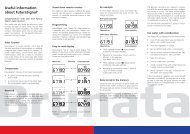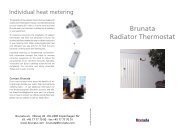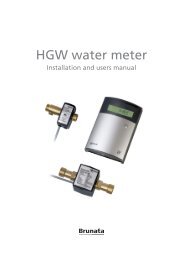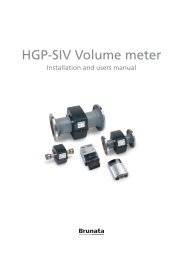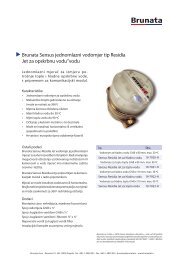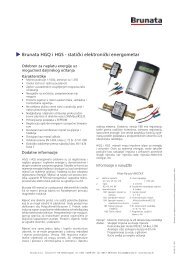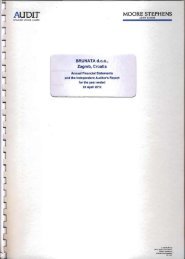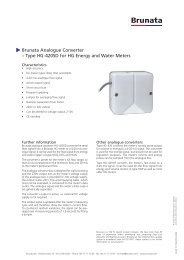Electronic Heat Cost Allocators - Brunata
Electronic Heat Cost Allocators - Brunata
Electronic Heat Cost Allocators - Brunata
Create successful ePaper yourself
Turn your PDF publications into a flip-book with our unique Google optimized e-Paper software.
E/R = emitted energy from the radiator per registered unit on the allocator<br />
M/Mn= Volume flow through the radiator in proportion to the norm volume flow<br />
(90/70/20). Radiator and allocator exponent = 1.3<br />
‘emergency solution’ which<br />
leads to significant registration<br />
errors – in particular when it<br />
comes to low temperature systems.<br />
Due to the radiators’ low<br />
average temperatures a considerable<br />
part of the heat emitted<br />
at low capacity (typically during<br />
autumn and spring) will not be<br />
recorded. Still, a considerable<br />
part of the heat absorbed during<br />
warm summer periods and<br />
later on emitted will be registered<br />
as consumption.<br />
The allocators are to be approved<br />
by accredited laboratories.<br />
These laboratories are<br />
designed and accredited for<br />
allocator testing (3). But they<br />
are not able to test allocators<br />
using (2).<br />
Documentation for the<br />
installation point<br />
In connection with new Danish<br />
requirements on type approvals,<br />
German laboratories have<br />
turned out to have tested and<br />
approved allocators without<br />
checking wheather the installation<br />
point, as stated by the<br />
manufacturer, is correct. Even if,<br />
according to the standard, this<br />
must be certified.<br />
All German allocators are installed<br />
in 75 % of the radiator<br />
height – regardless of make.<br />
Used as “documentation” for<br />
this installation point is an article<br />
in the German magazine<br />
“Heizung, Lüftung und Haustechnik”:<br />
Montageart für HKV<br />
nach dem Verdunstungsprinzip<br />
(HLH 1980/6). I.e. an article<br />
about evaporative heat cost allocators.<br />
All German electronic<br />
two-sensor allocators are also<br />
installed in this incorrect position<br />
of height, as the high point<br />
of installation for evaporative<br />
allocators must compensate for<br />
decreased registration at low<br />
capacity due to the relation to<br />
the air temperature – a problem<br />
which does not exist for electronic<br />
allocators.<br />
This has been clearly confirmed<br />
throughout the last 30<br />
years, during which <strong>Brunata</strong><br />
has carried out a number of<br />
tests on the correct installation<br />
point. It was, by the way,<br />
<strong>Brunata</strong>’s own tests on the installation<br />
point of evaporative<br />
heat cost allocators which lead<br />
to the tests referred to in HLH<br />
1980/6. <strong>Brunata</strong>’s tests on<br />
electronic heat cost allocators<br />
can be seen in figure 2, which<br />
shows three different installation<br />
heights.<br />
The Danish Agency for Development<br />
of Trade and Industry<br />
issue type approval certificates<br />
based on German type approvals,<br />
but they do not ask for<br />
proper documentation as to<br />
the point of installation. Thus,<br />
Danish customers will have to<br />
ask for special documentation.<br />
When the installation point is<br />
too high it implies that consum-<br />
ers do not receive the reduction<br />
in their heating bill to which<br />
they are entitled if lowering<br />
their consumption of heat. As<br />
a result a significant part of the<br />
incentive to lower ones heat<br />
consumption disappears. In<br />
consequence of this the cooling<br />
may become inadequate in the<br />
district heating system.<br />
Conclusion<br />
At the next revision the European<br />
Standard must be changed.<br />
It ought to focus more on allocators<br />
measuring the heat<br />
emission E. The present standard<br />
focuses on German conditions<br />
with relatively high dimensioned<br />
temperatures for<br />
heating systems (90/70/20).<br />
A revised standard should open<br />
the possibility for designing allocators<br />
whose specifications<br />
correspond to the conditions<br />
under which they are used, for<br />
instance dimensioned temperatures<br />
70/40/20, which is the<br />
case in Denmark. Furthermore,<br />
the administrative practice<br />
must be tightened so that allocators<br />
in non-compliance with<br />
the standard are not approved<br />
by national authorities.





